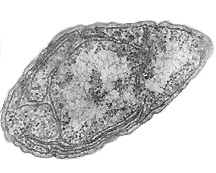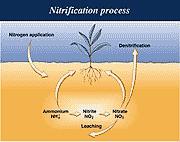Nitrosomonas europaea: Difference between revisions
| Line 58: | Line 58: | ||
[[Image:Nitrification.JPG|frame|right]] | [[Image:Nitrification.JPG|frame|right]] | ||
This nitrifying bacterium is the most studied of the ammonia-oxidizing bacteria that are participants in the biogeochemical N cycle. Nitrifying bacteria play a central role in the availability of nitrogen to plants and hence in limiting CO2 fixation. The reaction catalyzed by these bacteria is the first step in the oxidation of ammonia to nitrate. ''N.europaea'' also is capable of degrading a variety of halogenated organic compounds, including trichloroethylene, benzene, and vinyl chloride. The ability of nitrifying organisms to degrade some pollutants may make these organisms attractive for controlled bioremediation in nitrifying soils and waters. | |||
==Pathology== | ==Pathology== | ||
Revision as of 17:55, 3 May 2007
A Microbial Biorealm page on the genus Nitrosomonas europaea
Classification
Higher order taxa
Domain; Phylum; Class; Order; family [Others may be used. Use NCBI link to find]
Domain: Prokaryota
Phylum: Proteobacteria
Class: Beta Proteobacteria
Order: Nitrosomonadales
Family: Nitrosomonadaceae
Genus: Nitrosomonas
Species: N. europea
Species
|
NCBI: Taxonomy |
Nitrosomonas europaea
Description and significance
Describe the appearance, habitat, etc. of the organism, and why it is important enough to have its genome sequenced. Describe how and where it was isolated. Include a picture or two (with sources) if you can find them.
Nitrosomonas europaea is a Gram negative chemolithoautroph with the shape of bacillus. It is a nitrite oxidizing bacteria that lives in places rich in ammonia and inorganic salt, such as soil, sewage, freshwater, the walls of buildings and on the surface of monuments. It's often found in the polluted areas where the air contains high levels of nitrogen compounds.
It is important enough to have its genome sequenced because this organism plays a central role in the availability of nitrogen to plants and hence in limiting C02 fixation. These bacteria are important players in the treatment of industrial and sewage waste in the first step of oxidizing ammonia to nitrate. N. europaea is also capable of degrading a variety of halogenated organic compounds, including trichloroethylene , benzene and vinyl chloride, which may make it an attractive organism for bioremediation.
Genome structure
Describe the size and content of the genome. How many chromosomes? Circular or linear? Other interesting features? What is known about its sequence? Does it have any plasmids? Are they important to the organism's lifestyle?
Cell structure and metabolism
Describe any interesting features and/or cell structures; how it gains energy; what important molecules it produces.
Nitrosomonas europaea is an autotroph. It can obtain the carbon that it needs to grow by getting it from the atmosphere in a process known as "carbon fixation". Carbon fixation is the process of converting carbon in a gaseous form into carbon bound up in organic molecules. This bacterium contains "carboxysomes" (dark spots which can be seen scattered throughout the cell), which store the enzymes used to fix carbon dioxide for cell carbon.
Ecology
Describe any interactions with other organisms (included eukaryotes), contributions to the environment, effect on environment, etc.
This nitrifying bacterium is the most studied of the ammonia-oxidizing bacteria that are participants in the biogeochemical N cycle. Nitrifying bacteria play a central role in the availability of nitrogen to plants and hence in limiting CO2 fixation. The reaction catalyzed by these bacteria is the first step in the oxidation of ammonia to nitrate. N.europaea also is capable of degrading a variety of halogenated organic compounds, including trichloroethylene, benzene, and vinyl chloride. The ability of nitrifying organisms to degrade some pollutants may make these organisms attractive for controlled bioremediation in nitrifying soils and waters.
Pathology
How does this organism cause disease? Human, animal, plant hosts? Virulence factors, as well as patient symptoms.
Application to Biotechnology
Does this organism produce any useful compounds or enzymes? What are they and how are they used?
Current Research
Enter summaries of the most recent research here--at least three required
References
- Patrick Chain et al. (May 2003). "Complete Genome Sequence of the Ammonia-Oxidizing Bacterium and Obligate Chemolithoautotroph Nitrosomonas europaea". Journal of Bacteriology 185: 2759-2773.
- John G. Holt, Noel R. Krieg, editor, editor-in-chief (1984) Bergey's manual of systematic bacteriology volume2 page1809- 1825
- DOE JOINT GENOME INSTITUTE - US Department of Energy Office of Science http://genome.jgi-psf.org/finished_microbes/niteu/niteu.home.html
Edited by student of Rachel Larsen and Kit Pogliano


